Team TSA in Asia - August 2009
This report is the first to chronicle the daily activities of a TSA team’s visit to four countries in Asia – Myanmar, Thailand, Malaysia and Philippines - to design turtle facilities, develop conservation programs, and consult on turtle husbandry issues. The team is led by Rick Hudson and includes Lonnie McCaskill and Dave Manser. The team was met in Myanmar by Kalyar Platt and her father Nyunt Thein (a local retired civil engineer) in Yangon, Myanmar. The mission in Myanmar is to begin designing and “costing out” turtle and tortoise facilities that were recommended at the January 2009 workshop.
That workshop produced an aggressive five-year conservation action plan for Myanmar’s turtles, the implementation of which will be the responsibility of TSA and Wildlife Conservation Society (WCS). The team, working with our colleagues Khin Myo Myo and Kyaw Moe from WCS, will visit sites around the country, meet with Forestry Department, Zoo and Wildlife Sanctuary personnel to determine their needs, and then design facilities for both assurance colonies and rescue centers.
The journey begins
After more than 20 hours in the air, we land in Bangkok on August 15 and get some much needed rest. The next day, we travel to Yangon, Myanmar to await the arrival of Kalyar and her father, Nyunt Thein. Kalyar is fluent in both Burmese and English and is indispensable to our ability to communicate effectively (and she knows turtles!). Her father’s background and knowledge of local construction materials and costs are likewise essential to this mission. We spend the next day getting ready for our trip and on August 18, we fly to Myitkyina (pronounced Me-chee-na), our first destination.

Located in the northeastern part of the country, Myitkyina is close to the China border and lies along a major trade route including illegal wildlife. A “first response” rescue center was recommended here, meaning that this is where turtle confiscations would initially be staged, and animals sorted and treated, while decisions regarding their outcome (release, rehab, retention for assurance colony) are made. On August 19 we meet with Forestry Department staff and are shown a potential site. We evaluate the land, take measurements and then return to the hotel to work on designs. Due to the mild climate here, this area appears ideal for maintaining a group of mountain tortoises, Manouria emys, and we currently have a group of 65 of the northern race (phayrei) housed in crowded conditions at the zoo in Mandalay that need to be distributed to other facilities. Given that most confiscations in Myanmar also include numerous yellow tortoises (Indotestudo elongata), we design a facility primarily for tortoises with a few ponds for softshells and other aquatics.
Where this facility ends up in the overall priority ranking will depend on funding and other factors, but it is clear that we will have to invest heavily in training if this facility is to function properly. In fact, for the rescue component of this program to work effectively, we need to bring Steve and Kalyar Platt to Myanmar full-time to coordinate activities. Overseeing confiscations and assurance colonies would be Kalyar’s primary responsibility. To that end, a five year commitment for funding their salaries is being sought.
Visiting Old Friends
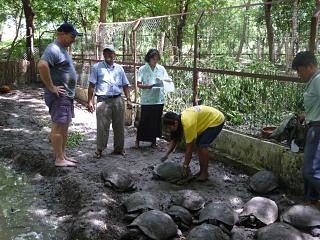
On August 20, we fly to Mandalay which lies in Myanmar’s central dry zone, the area that will be the base for the rest of the trip. We stop in at the Yadanabon Zoo to get reacquainted with staff and discuss our plans and goals. Over the years, the TSA and some of our partners have invested heavily in this zoo and have built nice facilities for both Burmese star tortoises and Burmese roof turtles. Both species are endemic, critically endangered and totally dependent on captive management for their survival. We go and check on some old friends – the group of Manouria emys mentioned earlier – and find them muddy but otherwise apparently “happy” in their crowded enclosure. One of our top priorities for this trip is to design an expanded facility here for this valuable group, while also looking for other suitable sites where we can establish additional colonies. This group is simply too large and important to maintain in one location. We take a look at several potential sites for another rescue facility- this one to be for intensive management and rehab of priority species to be maintained long term in breeding colonies. We also discuss the roof turtle facilities which, after only four years, have already reached capacity (242 B. trivittata now reside here and are growing at astounding rates!) and must be expanded. We begin making sketches and will return after a road trip with some computer drawings.
On to Lashio
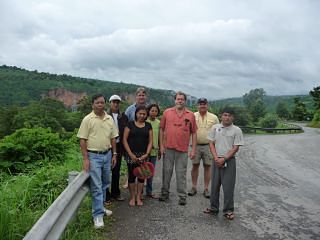
On August 21, we begin the long drive through the mountains of northeast to Lashio, capital of the Shan State. This is another common trade route to China and the site of multiple wildlife confiscations in the past. Because of this Lashio was designated as a priority for a first response rescue center. We get in late and meet with the Forestry Department the next day and drove to one of their base stations outside of town. It’s a beautiful piece of land with plenty of relief, a stream and adjacent to a hillside of moist tropical forest - ideal habitat for Manouria. Over the course of the day we designed a large facility including spacious habitats for both species of Manouria and other terrestrial species such as yellow tortoises and Heosemys depressa. Upstream, we propose a series of four ponds that would be fed with stream water and suitable for any number of aquatic species including large softshells. We return to the hotel and draft computer models of the facilities and then meet with the Director for approval. Next we will submit detailed drawings and cost estimates for construction, and hopefully we will be able to find the funding to get underway once we receive final approval from the Forestry Department.
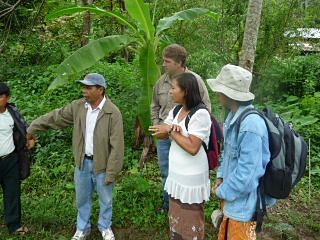
We got an enthusiastic response from the staff here as they had just this week handled a large confiscation of yellow and impressed tortoises and Lissemys. Without adequate facilities, and with turtles packed tightly in the seizure, mortality was high. The surviving yellow tortoises were packed six deep in the bed of a pickup truck (no doubt compounding mortality) and taken to a release site. They want to be able to do a better job and welcome TSA’s assistance. Because of their enthusiasm, we come away with a good feeling about the potential here and look forward to getting started.
The next morning (August 23), we head back to Mandalay, stopping off at Maymyo, home of the National Kandawgyi Botanic Garden. Located in a cool, mountain resort area that is very popular with both locals and tourists, it is only an hour drive from Mandalay. Here, we ran into a familiar face, Aung Mo Chit, who works for the WCS dolphin project part time and helps to manage the animal holdings – an extensive bird collection and some mammals - at the Garden. Due to the mild climate here, we had long recognized the potential for managing Manouria here, and we are soon formulating plans to make that idea a reality. We evaluate some potential sites and will seek formal approval in the coming months. With any luck, the large overcrowded group of 65 phayrei at Yadanabon Zoo will soon be split up and headed for more favorable climates.
Return to Mandalay
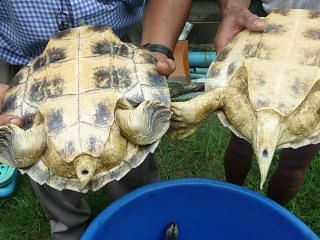
August 24 - Back in Mandalay, we buckle down for a busy day of work at the Yadanabon Zoo and there is plenty to do. The last time a TSA team worked here was two years ago, in August 2007, when we processed a large confiscation of Manouria emys, an incident that ranks as one of TSA’s finest hours. Again, we hit the ground running with multiple tasks to accomplish: Lonnie and Myo Myo begin processing the group of Manouria to check their weights and health status since 2007, Dave goes shopping for materials to resurface some turtle pools, and Rick and Kalyar drain the roof turtle pools so we can get hands on to determine the sex of the animals that hatched in 2006-07. We need to get all this done in the morning, so we can spend the afternoon designing the proposed rescue facility and finalize plans for expanded roof turtle and Manouria enclosures.
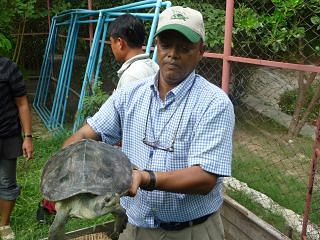
We regroup for lunch about 1:30 and Lonnie reports that all Manouria are “like rock” and have good weight and are well fed and hydrated. He is especially excited that his favorite tortoise, affectionately known as “burn boy,” survives. Bearing extensive shell damage from being badly burned in the past (his carapace actually appears melted in places) this old tortoise won our hearts in 2007 because he is such a survivor. Plus, knowing that he lives on after nearly winding up in a Chinese soup pot is especially gratifying. Dave mobilizes a crew that quickly gets busy retexturing some rough pool surfaces, and Rick is happy to report that we have both males and females in the large group of 2006 – 2007 hatched B. trivittata. This had been a concern due to the extended incubation periods (way past the normal 60 – 70 days) in those first years of the project, indicating low incubation temperatures that likely produce males. And on our first visit two days prior, most of the heads we saw at the pool surface bore distinct black markings, characteristic of males. We know now that we have a favorable sex ratio, that trivittata can be sexed in their third year (they grow remarkably fast), and that both sexes have prominent head markings when they are young.
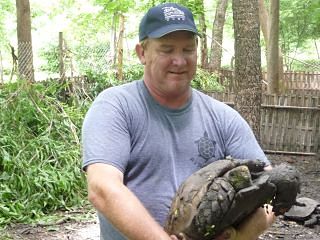
After lunch, we finalize designs for an expanded Manouria emys enclosure, and a major expansion of the Batagur trivittata facility. Pending final approval, we will double the size of the present Manouria area, subdivide it with low walls and gates for flexibility of management, and add six concrete pools that can be properly drained and cleaned. For the trivittata, we expand the area to include three large pools and an area where a series of 4 x 6 ft plastic tubs can be set up on racks for rearing hatchlings (presently hatchlings are reared inside, in plastic pans, with only 2-3 hours of sunlight per day). A nearby water hyacinth-filled filtration pond will be modified and fenced to accommodate the rapidly growing 2006 – 07 hatched juveniles, and allow them to reach adult size in deep water with little human contact. Finally, a new grow-out facility for rearing baby softshells is also planned. Currently, the Zoo is raising a group of endemic peacock softshell turtles (Nilssonia formosa) hatched from wild nests on the Upper Chindwin River, and we believe it only a matter of time before we have hatchling Chitra vandijki, another endemic softshell.
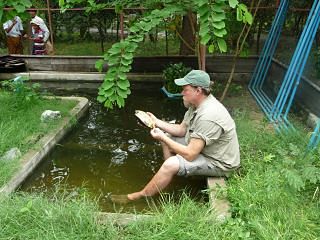
These new ponds will provide space for beginning new captive programs for these two poorly known species (both of which are heavily hunted) while providing experience in husbandry and management. We are very excited about the potential of both of these new facilities and we expect formal approval and construction by early 2010. Look for updates in the next TSA annual report and in our e-newsletters.
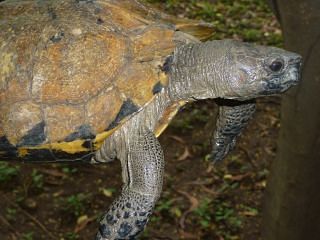
Finally, we wrap up the day with on site discussions for a new turtle rehabilitation and education center at the Zoo, and come up with some rough designs. We envision an intensive management facility for high profile species that have been rescued from the trade, alongside an interpretive center with graphics, artifacts, and space for public presentations. It is important to convey a clear message about the importance of turtles, the significance of Myanmar’s many unique and endemic species, and the threat that market hunting imposes.
Explaining this in the cont
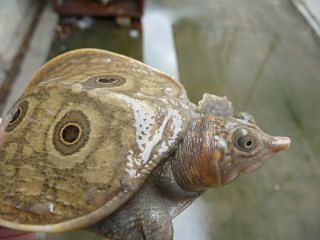
ext of why such a rescue center is needed is, we believe, an important take home message. With this concept in mind, Lonnie and Rick are discussing a 2010 grant application to the Disney Wildlife Conservation Fund.
The rest of our trip is all about Burmese star tortoises so stay tuned for the next posting.
-Rick Hudson, TSA President
